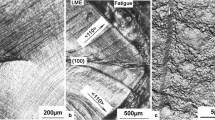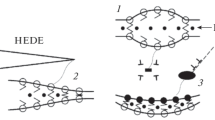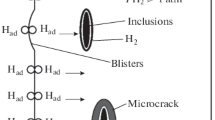Abstract
A new model is presented for hydrogen-assisted cracking (HAC) which explains the observations of decreasing microscopic plasticity and changes of fracture modes with decreasing stress intensities at crack tips during stress-corrosion cracking and HAC of quenched-and- tempered steels. The model suggests that the presence of sufficiently concentrated hydrogen dissolved in the lattice just ahead of the crack tip aids whatever deformation processes the microstructure will allow. Intergranular, quasicleavage, or microvoid coalescence fracture modes operate depending upon the microstructure, the crack-tip stress intensity, and the concentration of hydrogen. The model unifies several theories but shows how the stress-sorption and lattice embrittlement models are unnecessary. The model shows that planar pressure effects are necessary at low stress intensities and are necessary only to augment the driving force from the applied loads. The basic hydrogen-steel interaction appears to be an easing of dislocation motion or generation, or both.
Similar content being viewed by others
References
B. F. Brown, C. T. Fujii, and E. P. Dahlberg:J. Electrochem. Soc, 1969, vol. 116, p. 218.
B. F. Brown:Cont. Belg. Etude Corros., Rapp. Tech., 1970, vol. 112, pp. RT 170–71.
J. A. Smith, M. H. Peterson, and B. F. Brown:Corrosion, 1970, vol. 26, p. 539.
N. A. Nielsen:ASTM J. Mater., 1970, p. 794.
V. J. Colangelo and M. S. Ferguson:Corr.-NACE, 1969, vol. 25, p. 509.
D. O. Hayward and B. M. W. Trapnell:Chemisorption, First ed., p. 236, Butterworths, Washington, 1964.
A. R. Troiano:Trans. ASM, 1960, vol. 52, p. 54.
C. B. Gilpin, D. H. Paul, S. K. Asunman, and N. A. Tiner:Amer. Soc. Test. Mater., Spec. Tech. Publ., No. 396, 1966, p. 7.
F. deKazinczy:Jern. Kont. Ann., 1955, vol. 139, p. 885.
W. Beck, J. O’M Bockris, J. McBreen, and L. Nanis:Proc. Roy. Soc, 1966, vol. A290, p. 220.
D. I. Phalen and D. A. Vaughan:Corrosion, 1968, vol. 24, p. 243.
J. F. Hobson and C. Sykes:J. Iron Steel Inst., 1951,vol. 169,p.2O9.
R. P. Frohmberg, W. J. Barnett, and A. R. Troiano:Trans. ASM, 1955, vol. 47, p. 893.
A. S. Tetelman:Fracture of Solids, Int. Fracture Conf., Maple Valley, Wash. Interscience Publishers, New York, 1963.
R. Gibala:Trans. TMS-AIME, 1967, vol. 239, p. 1574.
J. B. Seabrook, N. J. Grant, and D. Carney:Trans. AIME, 1950, vol. 188, p. 1317.
H. C. Rogers:Acta Met., 1956, vol. 4, p. 114.
P. Bastien and P. Azou:Proc. First World Met. Cong., p. 535, ASM, Cleveland, 1952.
N. J. Grant and J. L. Lundsford:Iron Age, 1955, vol. 175, p. 92.
A. Cracknell and N. J. Petch:Acta Met., 1955, vol. 3, p. 200.
R. A. Vennett and G. S. Ansell:Trans. ASM, 1967, vol. 60, p. 242.
R. Morgan and B. Ralph:Acta Met., 1967,vol. 15, p. 341.
W. W. Gerberich and C. E. Hartbower:Fundamental Aspects of Stress Corrosion Cracking, p. 420, NACE, Houston, 1969.
J. H. Hoke:Corrosion, 1970, vol. 26, p. 396.
L. B. Pfeil:Proc. Roy. Soc. London, 1926, vol. Al 12, p. 182.
N. J. Petch and P. Stables:Nature, 1952, vol. 169, p. 842.
H. H. Uhlig:Corrosion and Corrosion Control, John Wiley, N. Y., 1963.
D. P. Smith:Hydrogen in Metals, University Press, Chicago, 1948.
L. S. Darken and R. P. Smith:Corrosion, 1949, vol. 5, p. 1.
E. W. Johnson and M. L. Hill:Trans. TMS-AIME, 1960, vol. 218, p. 1104.
A. McNabb and P. K. Foster:Trans. TMS-AIME, 1963, vol. 227, p. 618.
R. A. Oriani:Hydrogen in Metals, p. 446, NACE, Houston, 1969.
C. Zapffe and C. Sims:Trans. AIME, 1941, vol. 145, p. 225.
M. Smialowski:Hydrogen in Steel, Addison-Wesley, Reading, Mass., 1962.
A. S. Tetelman and W. Robertson:Trans. TMS-AIME, 1962, vol. 224, p. 775.
A. S. Tetelman:Fundamental Aspects of Stress Corrosion Cracking, p. 446, NACE, Houston, 1969.
Th. Weichselfelder:Liebigs. Ann. Chem., 1926, vol. 447, p. 64.
D. G. Westlake:Trans. ASM, 1969, vol. 62, p. 1000.
U. Lindborg:Int. J. Fract. Meek, 1968, vol. 4, p. 89.
D. Tromans and J. Nutting:Corrosion, 1965, vol. 21, p. 143.
E. A. Schuetz and W. D. Robertson:Corrosion, 1957, vol. 13, p. 437.
B. V. Whiteson, A. Phillips, V. Kerlins, and R. A. Rowe:Amer. Soc. Test. Mater., Spec. Tech. Publ. 436, ASTM, Philadelphia, 1968.
H. H. Johnson:Fundamental Aspects of Stress Corrosion Cracking, p. 439, NACE, Houston, 1969.
C.F. Barth and E. A. Steigerwald:Met. Trans., 1970,vol. 1,p. 3451.
C. D. Beachem, T. C. Lupton, and B. F. Brown:Met. Trans., 1971, vol. 2, p. 141.
Fracture Toughness Testing and Its Applications, Amer. Soc. Testing Mater., Spec. Tech. Publ. No. 381, Philadelphia, 1965.
C. D. Beachem and R. M. N. Pelloux:Fracture Toughness Testing and Its Applications, Amer. Soc. Testing Mater, Spec. Tech. Publ. No. 381, p. 210, Philadelphia, 1965.
E. P. Dahlberg:Trans. ASM, 1965, vol. 58, p. 46.
C. D. Beachem:Trans. ASM, 1963, vol. 56, p. 318.
G. Sandoz: NRL, Washington, D. C, unpublished research, 1970.
G. G. Hancock and H. H. Johnson:Trans. TMS-AIME, 1966, vol. 236, p. 513.
D. P. Williams and H. G. Nelson:Met. Trans., 1970, vol. 1, p. 63.
M. H. Peterson, B. F. Brown, R. L. Newbegin, and R. E. Groover:Corrosion, 1967, vol. 23, p. 142.
A. M. Sullivan:Amer. Soc. Test. Mater., Mater. Res. Stand., 1964, vol. 4, p. 20.
ASTM Standards, Part 31, p. 913,Amer. Soc. Test. Mater., Philadelphia, 1970.
C. D. Beachem and D. A. Meyn:Amer. Soc. Test. Mater, Spec. Tech. Publ. 436, p. 59, ASTM, Philadelphia, 1968.
A. Phillips, V. Kerlins, and B. V. Whiteson:Electron Fractography Handbook, AFML-TR-64-416, Wright Patterson AFB, Dayton, 1965.
R. G. Baker and F. Watkinson:Hydrogen in Steel, Iron Steel Spec. Rep. No. 73, p. 123, London, 1962.
H. C. Rogers:Science, 1968, vol. 159, p. 1057.
C. D. Beachem, J. A. Kies, and B. F. Brown:Amer. Soc. Testing Mater., Mater. Res., April 1971.
D. Webster:Met. Trans., 1970, vol. 1, p. 2919.
E. Snape:Corrosion-NACE, 1968, vol. 24, p. 261.
Author information
Authors and Affiliations
Rights and permissions
About this article
Cite this article
Beachem, C.D. A new model for hydrogen-assisted cracking (hydrogen “embrittlement”). Metall Trans 3, 441–455 (1972). https://doi.org/10.1007/BF02642048
Received:
Published:
Issue Date:
DOI: https://doi.org/10.1007/BF02642048




